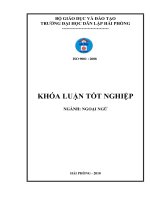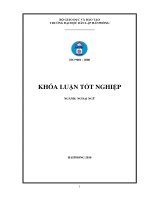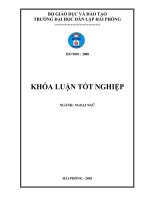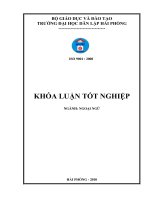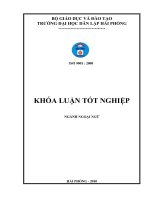khóa luận tiếng anh a study on translation of english terminologies related to logistics
Bạn đang xem bản rút gọn của tài liệu. Xem và tải ngay bản đầy đủ của tài liệu tại đây (1.21 MB, 51 trang )
BỘ GIÁO DỤC VÀ ĐÀO TẠO
TRƯỜNG ĐẠI HỌC DÂN LẬP HẢI PHÒNG
-------------------------------
ISO 9001:2015
KHÓA LUẬN TỐT NGHIỆP
NGÀNH : NGÔN NGỮ ANH
Sinh viên
: Đỗ Tân Cương
Giảng viên hướng dẫn : Th.S Vũ Thị Thu Trang
HẢI PHÒNG - 2019
BỘ GIÁO DỤC VÀ ĐÀO TẠO
TRƯỜNG ĐẠI HỌC DÂN LẬP HẢI PHÒNG
-----------------------------------
A STUDY ON TRANSLATION OF ENGLISH
TERMINOLOGIES RELATED TO LOGISTICS
KHÓA LUẬN TỐT NGHIỆP ĐẠI HỌC HỆ CHÍNH QUY
NGÀNH: NGÔN NGỮ ANH
Sinh viên
: Đỗ Tân Cương
Giảng viên hướng dẫn : Th.S Vũ Thị Thu Trang
HẢI PHÒNG - 2019
BỘ GIÁO DỤC VÀ ĐÀO TẠO
TRƯỜNG ĐẠI HỌC DÂN LẬP HẢI PHÒNG
--------------------------------------
NHIỆM VỤ ĐỀ TÀI TỐT NGHIỆP
Sinh viên: Đỗ Tân Cương
Mã SV: 1412751027
Lớp: NA1801
Ngành: Ngôn Ngữ Anh
Tên đề tài:
A study on translation of English terminologies related to logistics
NHIỆM VỤ ĐỀ TÀI
1. Nội dung và các yêu cầu cần giải quyết trong nhiệm vụ đề tài tốt nghiệp
(Về lý luận, thực tiễn, các số liệu cần tính toán và các bản vẽ).
……………………………………………………………………………..
……………………………………………………………………………..
……………………………………………………………………………..
……………………………………………………………………………..
……………………………………………………………………………..
……………………………………………………………………………..
……………………………………………………………………………..
……………………………………………………………………………..
2. Các số liệu cần thiết để thiết kế, tính toán.
……………………………………………………………………………..
……………………………………………………………………………..
……………………………………………………………………………..
……………………………………………………………………………..
……………………………………………………………………………..
……………………………………………………………………………..
……………………………………………………………………………..
……………………………………………………………………………..
……………………………………………………………………………..
3. Địa điểm thực tập tốt nghiệp.
……………………………………………………………………………..
……………………………………………………………………………..
……………………………………………………………………………..
CÁN BỘ HƯỚNG DẪN ĐỀ TÀI TỐT NGHIỆP
Người hướng dẫn thứ nhất:
Họ và tên:.............................................................................................
Học hàm, học vị:...................................................................................
Cơ quan công tác:.................................................................................
Nội dung hướng dẫn:............................................................................
Người hướng dẫn thứ hai:
Họ và tên:................................................................................. ............
Học hàm, học vị:...................................................................................
Cơ quan công tác:.................................................................................
Nội dung hướng dẫn:............................................................................
Đề tài tốt nghiệp được giao ngày
tháng
năm
Yêu cầu phải hoàn thành xong trước ngày
tháng
Đã nhận nhiệm vụ ĐTTN
Đã giao nhiệm vụ ĐTTN
Sinh viên
năm
Người hướng dẫn
Hải Phòng, ngày ...... tháng........năm 2019
Hiệu trưởng
GS.TS.NGƯT Trần Hữu Nghị
CỘNG HÒA XÃ HỘI CHỦ NGHĨA VIỆT NAM
Độc lập - Tự do - Hạnh phúc
PHIẾU NHẬN XÉT CỦA GIẢNG VIÊN HƯỚNG DẪN TỐT NGHIỆP
Họ và tên giảng viên:
...................................................................................................
Đơn vị công tác:
........................................................................ ..........................
Họ và tên sinh viên:
.......................................... Chuyên ngành: ...............................
Đề tài tốt nghiệp:
...................................................................................................
........................................................... ........................................
Nội dung hướng dẫn:
.......................................................... ........................................
....................................................................................................................................
1. Tinh thần thái độ của sinh viên trong quá trình làm đề tài tốt nghiệp
..............................................................................................................................................
..............................................................................................................................................
..............................................................................................................................................
..............................................................................................................................................
..............................................................................................................................................
..............................................................................................................................................
2. Đánh giá chất lượng của đồ án/khóa luận (so với nội dung yêu cầu đã đề ra trong
nhiệm vụ Đ.T. T.N trên các mặt lý luận, thực tiễn, tính toán số liệu…)
..............................................................................................................................................
..............................................................................................................................................
..............................................................................................................................................
..............................................................................................................................................
..............................................................................................................................................
..............................................................................................................................................
3. Ý kiến của giảng viên hướng dẫn tốt nghiệp
Được bảo vệ
Không được bảo vệ
Điểm hướng dẫn
Hải Phòng, ngày … tháng … năm ......
Giảng viên hướng dẫn
(Ký và ghi rõ họ tên)
CỘNG HÒA XÃ HỘI CHỦ NGHĨA VIỆT NAM
Độc lập - Tự do - Hạnh phúc
PHIẾU NHẬN XÉT CỦA GIẢNG VIÊN CHẤM PHẢN BIỆN
Họ và tên giảng viên:
..............................................................................................
Đơn vị công tác:
........................................................................ .....................
Họ và tên sinh viên:
...................................... Chuyên ngành: ..............................
Đề tài tốt nghiệp:
......................................................................... ....................
....................................................................................................................................
....................................................................................................................................
1. Phần nhận xét của giáo viên chấm phản biện
..........................................................................................................................................
..........................................................................................................................................
..........................................................................................................................................
..........................................................................................................................................
..........................................................................................................................................
..........................................................................................................................................
..........................................................................................................................................
2. Những mặt còn hạn chế
..........................................................................................................................................
..........................................................................................................................................
..........................................................................................................................................
..........................................................................................................................................
..........................................................................................................................................
..........................................................................................................................................
..........................................................................................................................................
3. Ý kiến của giảng viên chấm phản biện
Được bảo vệ
Không được bảo vệ
Điểm phản biện
Hải Phòng, ngày … tháng … năm ......
Giảng viên chấm phản biện
(Ký và ghi rõ họ tên
QC20-B19
ACKNOWLEDGEMENT
In the process of completing this graduation paper, I have faced up with
many problems with lexicology, as well as the way to express my ideas.
However, with the great help, guidance and encouragement from my teachers,
my family and my friends, I have overcome these difficulties and completed this
graduation paper successfully.
First of all, to express my deepest gratitude and indebtedness to my
supervisor – Ms. Vu Thi Trang, M.A- who has always been most willing and
ready to give me valuable advice, inspiration and supervision to finish this study.
My sincere thanks are also sent to the teachers in the Foreign Language
Department of Haiphong Private University for their useful lessons and wholehearted advice during four years studying here.
Last but not least, I would like to give my heartfelt thanks to my family
and my close friends, to whom I have never got enough words to express my
great gratitude for their encouragement and support.
This graduation paper is my sincere thanks to all of you.
Haiphong, December 2019
Do Tan Cuong
i
LIST OF ACRONYMS:
SL
Source language
TL
Target language
ADJ
Adjective
ADV
Adverb
N
Noun
V
Verb
ESP
English for Specific Purpose
ST
Source Text
TT
Target Text
ELT
English Language Teaching
EAP
English for Academic Purpose
EBE
English for Business Economics
EOP
English for Occupational Purpose
ESBP
English for Specific Business Purpose
ESS
English for Social Study
EST
English for Science and Technology
iii
CONTENTS
PART ONE: INTRODUCTION ........................................................................... 1
1. Rationale of the study:....................................................................................... 1
2. Aims of the study ................................................................................................. 1
3. Scope of the study: ............................................................................................... 2
4. Methods of the study: ........................................................................................... 2
All of English and Vietnamese terms in this graduation paper are collected from
internet and dictionary. These data are divided into groups based on their common
character. .................................................................................................................. 2
5. Design of the study .............................................................................................. 2
PART TWO: DEVELOPMENT ........................................................................... 3
CHAPTER I ........................................................................................................... 3
THEORETICAL BACKGROUND ...................................................................... 3
1. Translation Theory ............................................................................................... 3
1.1. Definition of translation .................................................................................... 3
There are many concepts of translation all over the world. Following are some
typical concepts: ....................................................................................................... 3
1.2. Translation types ............................................................................................... 4
1.2.1. Word-for-word translation ............................................................................. 4
1.2.2. Literal translation ........................................................................................... 4
1.2.3. Faithful translatio ........................................................................................... 5
1.2.4. Semantic translation ....................................................................................... 5
1.2.5. Adaptation translation .................................................................................... 6
1.2.6. Free translation ............................................................................................... 6
1.2.7. Idiomatic translation....................................................................................... 7
1.2.8. Communicative translation............................................................................. 7
1.2.9. Other translation ............................................................................................. 7
1.3. Types of equivalence......................................................................................... 8
1.4. Case of non-equivalence ................................................................................... 9
iii
2.
ESP in translation ............................................................................................ 10
2.1. D efinition of ESP ......................................................................................... 10
2.1.2. Variable characteristics ................................................................................ 10
2.2. Types of ESP ................................................................................................... 10
3. Terms in English: ............................................................................................... 11
3.1. Definition of a term ......................................................................................... 12
3.2. The characteristics of terms:............................................................................ 12
3.3. Terms of Logistics: ......................................................................................... 13
CHAPTER
II:A
STUDY
ON
TRANSLATION
OF
ENGLISH
TERMINOLOGIES RELATED TO LOGISTICS ........................................... 14
1. Overview of Logistics ..................................................................................... 14
1.1 Definition of Logistics ..................................................................................... 14
1.2. Some features of Logistics field in Vietnam ................................................... 15
2. The popular construction of terms and strategies applied for translating Logistics
terms ...................................................................................................................... 15
2.1. Single terms .................................................................................................... 15
2.2. Compound terms ............................................................................................. 16
2.3. Phrases ............................................................................................................ 20
2.4. Abbreviations .................................................................................................. 20
3. Popular strategies and procedures applied in the translation of some common
Logistics terms into Vietnamese ............................................................................ 23
3.1. Procedures applied in the Equivalence Translation ......................................... 23
3.1.1. Literal Translation ........................................................................................ 23
3.1.2 Shift or transposition translation ................................................................... 24
3.2. Popular strategies and procedures applied in Non-equivalence....................... 25
3.2.1. Translation by paraphrasing unrelated words ............................................... 25
3.2.2. Translation by paraphrasing related words ................................................... 26
3.2.3. Translation by addition................................................................................. 27
3.2.4. Translation by using loan words .................................................................. 28
CHAPTER III: FINDING AND DISCUSSION ............................................... 29
1. Main finding....................................................................................................... 29
iv
2. Suggestions for translation of Logistics terms ................................................... 29
PART THREE: CONCLUSION ......................................................................... 31
REFERENCES ...................................................................................................... 32
APPENDIX 1 (Vocabulary) ................................................................................... 33
Appendix 2(Exercise) ............................................................................................ 37
APPENDIX 3 (Translation sample) ....................................................................... 38
v
PART ONE: INTRODUCTION
1. Rationale of the study:
In the context of a rapidly growing economy, Logistics has emerged as a
solution to the needs of production and distribution of products to consumers
convenience and speed. Therefore, Logistics has gradually affirmed its great role
in the economy of many countries in the world, including Vietnam.
Logistics are the best service, the best transport from the place of production to
the consumer. The task of the logistics companies prepare plan in detail, control
the movement of goods or information about raw materials from point of
departure to point of consumption according to customer requirements. To
compete effectively in this industry, companies must always improve and focus
on the quantity, time and price of services. This motivates me – a student of
Haiphong Private University who has
approached the modern education and
some new training programs of my university, therefore, I have been attracted
by the programs and its terms. I find it is a challenging field and should
understand terms in Logistics. For these reasons, I have chosen “A study on
translation of English terminologies related to logistics” for my graduation paper.
2. Aims of the study
The study on translation of education terms aims to figure out an overview on
translation strategies and procedures commonly employed in translation of
Logistics terms.
In details, my Graduation Paper aims at:
Collecting and presenting basic English terminologies in Logistics terms.
Providing their Vietnamese equivalents or expressions
Analyzing translation strategies and procedures employed in the translation of
these English terms into Vietnamese.
Providing students majoring in the subject and those who may concern a draft
and short reference of basic English terms in Logistics .
1
I hope that this study can provide readers with overall comprehension about the
information from written text and from visual forms of presentation relating to
Logistics terms, and ultimately to help them translate it effectively.
3. Scope of the study:
Logistics field is an extremely large field. Due to the limitation of time,
knowledge and experience, I am not ambitious to study all matters of this theme
but only focus on translation theory and translation strategies of some major
Logistics terms in Vietnamese.
4. Methods of the study:
This Graduation paper is carried out by using the quantitative _ interviews,
consultation, qualitative_ data analysis and searching information…
All of English and Vietnamese terms in this graduation paper are collected from
internet and dictionary. These data are divided into groups based on their
common character.
5. Design of the study
My graduation paper is divided into three parts:
The first part is the Introduction, including: the rationale, aims, scope, method
and design of the study.
The second part is the Development with three chapters:
Chapter I: Theoretical background: It focuses on the concepts of translation,
terms in English and form of language as well as different methods used by
professional translators.
Chapter II: A study on translation of English terminologies related to logistics,
including the popular construction of terms and some strategies applied in
translation of some common Logistics terms
Chapter III: Finding and Discussion
The last part is the Conclusion in which I summarize the study to highlight
experiences acquired and state the implications for future study.
2
PART TWO: DEVELOPMENT
CHAPTER I
THEORETICAL BACKGROUND
1. Translation Theory
1.1. Definition of translation
There are many concepts of translation all over the world. Following are some
typical concepts:
Translation is the replacement of a representation of a text in one language by a
representation of an equivalent text in a second language.
(Roger T. Bell)
Translation is the interpreting of the meaning of a text and the subsequent
production of an equivalent text, like wise called a “translation” that
communicates the same message in another language. The text to be translated
is called the “source text”, and the language that it is to translate into is called
the “target language”; the final product is sometimes called the “target text”.
( />Translation is the process of changing something that is written or spoken into
another language.
(Advanced Oxford Dictionary)
Translation is an act of communication which attempts to relay, across cultural
and linguistic boundaries, another act of communication. Hatim and Mason
(1997; 1) Translation involves the transfer of meaning from a text in one
language into a text in another language.
(Bell, 1991: 8)
Translation is a text with qualities of equivalence to a prior text in another
language, such that the new text is taken as a substitute for the original.
(David Frank, Wordpress.com)
3
Translation is a transfer process, which aims at the transformation of a written
SL text into an optimally equivalent TL text, and which requires the syntactic,
the semantic and the pragmatic understanding and analytical processing of the
SL.
(Wilss1982:3)
There are many different definitions for translation as each translator, researcher,
linguist, etc. defines their own idea to understand the concept of translation.
Although the above definitions are different, they have some common features
generally. To summarize, translation is a process of finding the most adequate
equivalents to convey meanings from source language to target language.
1.2. Translation types
A translator can use various types to express his or her opinion, recognition or to
find out the most extract explanation for the main issue. The central problem of
translating is whether to translate literally or freely. It all depends on some
factors such as the purpose of the translation, the nature of readership and the
text types.
As stated by Peter Newmark (1988:45) there are eight method of translation.
And basing on the degree of emphasis on the SL and TL, he puts it in a flattened
diagram as below:
1.2.1. Word-for-word translation
This is often demonstrated as interline translation, with the TL immediately
below the SL words. The source language word order is preserved and the words
translated by their most common meaning. Cultural words are translated literally.
The main use of this method is either to understand the mechanics of the source
language or to construe a difficult text as pretranslation process.
For example:
Cristiano Ronaldo is a football player living and playing football in Italy.
Cristiano Rnaldo là một cầu thủ bóng đá đang sống và chơi bóng tại Italia.
1.2.2. Literal translation
4
Literal translation is a boarder form of translation, each SL word has a
corresponding TL word, but their primary meaning may differ. The SL
grammatical constructions are converted to nearest TL equivalent but the lexical
items are again translated out of context. Literal translation is considered the
basic translation step both in communication and semantic translation, in that
translation starts from there. As pre-translation process, it indicates problem to
be solved.
For example:
I tried for a moment to see the situation through her eyes
Tôi đã thử một lần cố nhìn nhận tình huống theo cách nhìn của cô ta
1.2.3. Faithful translatio
This method tries to reproduce the precise contextual meaning of the original
within the constraint of the TL grammatical structures. It transfers cultural
words and preserves the degree of grammatical and lexical deviation from
source language norms. It attempts to be completely faithful to the intention and
the text-realization of the source language writer.
For example:
We could see the Mekong River winding its way through the plains below.
Chúng tôi có thể nhìn thấy con sông Mekong uốn khúc qua những cảnh đồng
bên dưới.
1.2.4. Semantic translation
Semantic translation differs from faithful translation only in as far as it must
take more account of the aesthetic value of the SL text, compromising on
“meaning” where appropriate so that no assonance, word-play or repetition jars
in finished version. It does not rely on cultural equivalent and makes very small
concession to the readership. While “faithful” translation is dogmatic, semantic
translation more flexible. New Mark (1982:22) says that “…semantic constraints
of the target language, to reproduce the price contextual meaning of the author”.
For example:
5
The third world is vulnerable owing to its extreme specialization. The export
earnings of many developing countries are based on just two or three main
products.
Thế giới thứ ba dễ dàng bị tổn thất vì sự chuyên môn hóa quá mức. Ở nhiều
nước đang phát triển, Thu nhập từ xuất khẩu chủ yếu dựa vào hai hay ba sản
phẩm chủ lực mà thôi.
1.2.5. Adaptation translation
This is the “freest” form of translation. It is used mainly for plays and poetry:
themes, characters, plot preserved, SL culture is converted into the TL culture
and is rewritten. Dung Vu (2004) points out: “adaptation has a property of
lending the ideas of the original to create a new text used to by a new language
more than to be faithful to the original. The creation in adaptation completely
objects in content as well as form”.
For example:
Below the bridge runs the current pure and clear
And there the grass grows soft, by the bridge.
Ngồi đầu cầu nước trong như lọc
Đường bên cầu cỏ mọc còn non.
1.2.6. Free translation
Free translation is the translation which is not close to the original but the
translation just transmits meanings of the SL in her/his own words. It reproduces
the matter without the manner, or the content with out of the form of the original.
Usually, it is a paraphrase much longer than original. Therefore, the advantage
of this type of translation is that the text in TL sounds more natural. On the
contrary, the disadvantage is that translating is too casual to understand the
original because of its freedom.
For example:
6
Winter snows, I thought, had drifted through that void arch, winter rains beaten
in at those hollow casements.
Tôi đã tưởng tượng ra ngững hạt tuyết mùa đông đã buồn qua khung cửa tò vò,
rồi những cơn mưa rơi tí tách đập vào khung của sổ rỗng tuếch đó.
1.2.7. Idiomatic translation
Idiomatic translation reproduces the “message” of the original but tends to
distort nuances of meaning by preferring colloquialisms and the idiom where
these do not exist in the original.
For example:
As the call, so the echo
Ác giả, ác báo.
1.2.8. Communicative translation
Communicative translation attempts to reader the exact contextual meaning of
the original in such a way that both content and language are readily acceptable
and comprehensible to the readership.
“But even here the translation still has to respect and work on the form of the
source language text as the only material basis for his work” (Peter Newmark,
1982:39).
For example:
Safety. In the United State, the Food and Drug Administration (FDA) applies
strict controls before authorizing the launch of a new drug on the American
market.
Sự an toàn. Ở Mỹ, Cục Quản Lý Dược và Thực Phẩm áp dụng sự kiểm soát
nghiêm ngặt trước khi cho phép đưa ra thị trường Mỹ một sản phẩm dược mới.
1.2.9. Other translation
Beside the above common the types of translation, some of the following types
are sometimes used during translation process. They include: service translation,
7
plum prose translation, information translation, cognitive translation, academic
translation.
1.3. Types of equivalence
The comparison of texts in different language inevitably involves a theory of
equivalence. According to Vanessa Leonardo “Equivalence can be said to be the
central issue in the translation although its definition, relevance, and
applicability within the fields of translation theory have caused heated
controversy, and many different theories of the concept of equivalence have
been elaborated within the past fifty years”. Here are some elaborate approaches
to translation equivalences:
Equivalence-oriented translation is a procedure which replicates the same
situation as in the original, whilst using completely different wording.
(Vinay and Darbelnet)
Translation equivalence exists between forms in a source language and a target
language if their meaning matches. In other words, translation equivalence
should answer the question “What do the speakers of this language actually say
to express the desired meaning?”
Wayne Leman (Wordpress.com)
Equivalence, when applied to the issue of translation, is an abstract concept and
actually refers to the equivalence relationship between the source text and the
target text.
Asian social science (CCSE)
Types of equivalences:
Koller (1979) considered 5 types of equivalences:
1. Denotative equivalence
The source language and the target language words refer to the same thing in
real world. It is an equivalence of the extra linguistic content of a text.
2. Connotative equivalence
8
This type of equivalence provides additional values besides denotative value and
is achieved by the translator’s choice of synonymous words or expressions.
3. Text-normative equivalence
The source language and the target language words are used in the same or
similar context in their respective languages.
4. Pragmatic equivalence
With readership orientation, the source language and the target language words
have same effect on their respective readers.
5. Formal equivalence this type of equivalence procedures an analogy of form in
the translation either exploiting formal possibilities of target language, or
creating new forms in target language.
Based on Nida’s theory, equivalence was divided into 2 kinds:
1. Formal equivalence focuses attention on the message in form. The message in
the receptor language should match as closely as possible the different element
in some languages.
2. Dynamic equivalence, or function equivalence follows the principle of
equivalent effect, that is the relationship between the receptor and the message
should aim at being the same as that between the original receptor and the
source language message. It attempts to render receptor words from one
language to another, and caters to receptor’s linguistic competence and cultural
need.
1.4. Case of non-equivalence
According to Mona Baker, the concept of non-equivalence at word level is more
and less as follow: “non-equivalence at word level means that the target
language has no direct equivalence for a word which occurs in the source text”.
Non-equivalence happens occasionally in translation due to differences between
SL and TL. It is quite possible that there is no identical TL version of a SL text
which has been translated by various translation competences and even if the
outward condition for the translation of the particular text are identical.
9
One of the cases of non-equivalence in translation happens due to the selfnation
concept.
2.
ESP in translation
2.1. D efinition of ESP
ESP is the abbreviation for English for specific purpose. It is defined in the other
ways. Some people described ESP as simply being of English for any purpose
that could be specified. Others, however, were more precise, describing it as the
teaching of English used in academic studies or the teaching of English for
vocational or professional purposes.
Tony Dudley-Evans, co-editor of the ESP Journal gives an extended definition
of ESP in terms of 'absolute' and 'variable' characteristics (see below).
Definition of ESP (Dudley-Evans, 1997)
2.1.2. Variable characteristics
ESP may be related to or designed for specific disciplines.
ESP may use in specific teaching situations, a different methodology from that
of General English.
ESP is likely to be designed for adult learners, either at a tertiary level institution
or in a professional work situation. It could, however, be for learners at
secondary school level.
ESP is generally designed for intermediate or advanced students.
Most ESP courses assume some basic knowledge of the language systems.
2.2. Types of ESP
David Carter (1983) identifies three types of ESP:
English as a restricted language.
English for Academic and Occupational Purposes.
English with specific topics.
- The language used by air traffic controllers or by waiters are examples of
English as a restricted language. Mackay and Mountford (1978) clearly illustrate
the difference between restricted language and language with this statement:
10
“... The language of international air-traffic control could be regarded as
'special', in the sense that the repertoire required by the controller is strictly
limited and can be accurately determined situation, as might be the linguistic
needs of a dining-room waiter or air-hostess. However, such restricted
repertoires are not languages, just as a tourist phrase book is not grammar.
Knowing a restricted 'language' would not allow the speaker to communicate
effectively in novel situation, or in contexts outside the vocational environment”.
- The second type of ESP identified by Carter (1983) is English for Academic
and Occupational Purposes. In the 'Tree of ELT' (Hutchinson & Waters, 1987),
ESP is broken down into three branches:
a) English for Science and Technology (EST)
b) English for Business and Economics (EBE)
c) English for Social Studies (ESS)
Each of these subject areas is further divided into two branches:
English for Academic Purposes (EAP)
English for Occupational Purposes (EOP).
An example of EOP for the EST branch is 'English for Technicians' whereas an
example of EAP for the EST branch is 'English for Medical Studies'.
- The third and final type of ESP identified by Carter (1983) is English with
specific topics. Carter notes that it is only here where emphasis shifts from
purpose to topic. This type of ESP is uniquely concerned with anticipated future
English needs of, for example, scientists requiring English for postgraduate
reading studies, attending conferences or working in foreign institutions.
However, I argue that this is not a separate type of ESP. Rather it is an integral
component of ESP courses or programs which focus on situational language.
This situational language has been determined based on the interpretation of
results from needs analysis of authentic language used in target workplace
setting.
3. Terms in English:
11
3.1. Definition of a term
In “Dictionary of Linguistic Terminology” (1997) there are 15 different
definitions of terminology. According to Nguyen Van Tu (1960:176):
“terminology is a word or combination of words that is used in science,
technology, politics, art… and it has specific meaning, denotes precise concepts
and names of above- mentioned scientific areas”.
According Russian
author in
“Russian
Encyclopedia”
(1976:473-474)
“terminology is a word or a combination of words that denotes the concept
precisely and its relationship with other concept in specific area. Terminology is
a specialized and restricted expression on things, phenomenon, characteristic,
and the relationships in specific profession”.
Many Vietnamese linguistics such as Do Huu Chau (1998), Luu Van Lang
(1979), also provided definitions of terminology. Do Huu chau claims: “terms
are specialist words used within a scientific field, a profession or any
technological field”. Yet, the newest and most informative definition was the
one by Nguyen Thien Giap (1985:308-309). He claimed that terminology, which
is understood as a specific linguistic unit of a language, consist of word and
fixed phrase that provides precise definition on objective that belong to a
particular scientific area. In “the conference on Building Terminology System”
held by the State Community of Science (1969, Ha Noi) general criteria of
terminology were discussed the concluded that the following qualities should be
in terminology: (1) accurateness, (2) systematize, (3) internationalism.
3.2. The characteristics of terms:
There is distinction between technical and descriptive terms. The original source
language writer may use a descriptive term for a technical object for three
reasons:
The objective is new and not yet has a name.
The descriptive term is being used as a familiar alternative, to avoid repetition.
12
The descriptive term is being used to make a contrast with another one.
Normally, you should translate technical and descriptive terms by their
counterparts and, in particular, resist the temptation of translating a descriptive
by a technical term for showing off your knowledge, there by sacrificing the
linguistic force of the SL descriptive term. However, if the SL descriptive term
is being used either because of the SL writer’s ignorance or negligence, or
because the appropriate technical term does not exist in the SL, and in particular
if an object strange to the SL but not to the TL culture is being referred to, then
you are justified in translating a descriptive by a technical term.
Terminology makes up perhaps 5-10 % of a text. The rest is “language” usually
a natural style of language; and there you normally find an authoritative text
aspires to such a style; if it does not, you gently convert it to natural and elegant
language-the write will be grateful to you.
3.3. Terms of Logistics:
According to structure, Logistics Terms consist of following types:
Single terms are those that consist of just one word, example: Export, Customer,
Import, etc…
Compound terms are terms consisting of two or more words, most of them are
compound nouns
Phrases: Most of them are noun phrases: Commission based agent, Exclusive
distributor, Export-import procedures, etc…
Abbreviations: OEM: original equipment manufacturer, VAT: value added tax,
GST: goods and service tax, etc…
13

